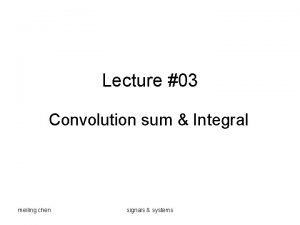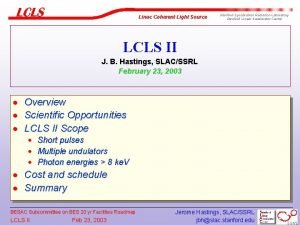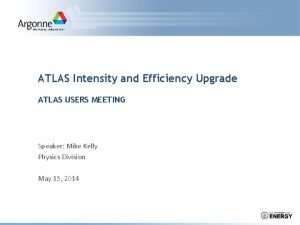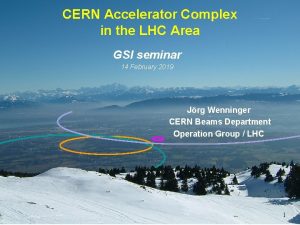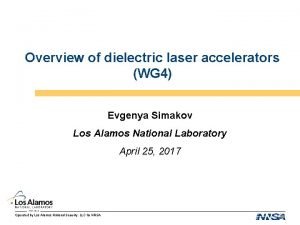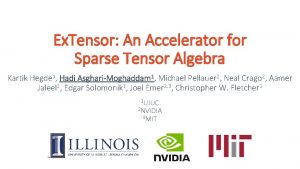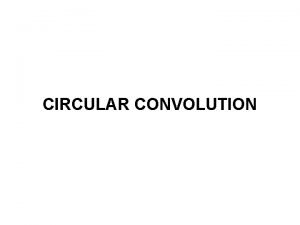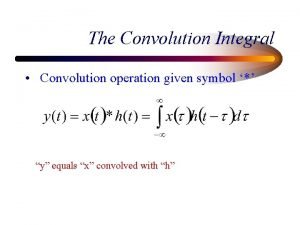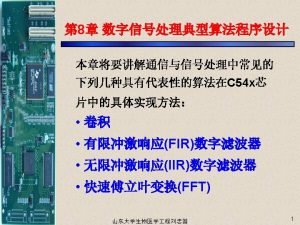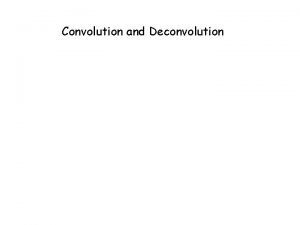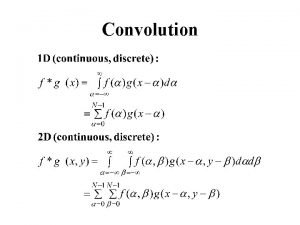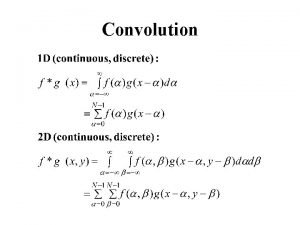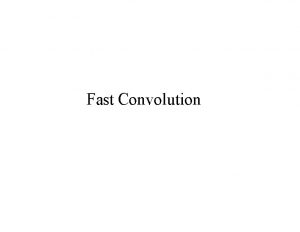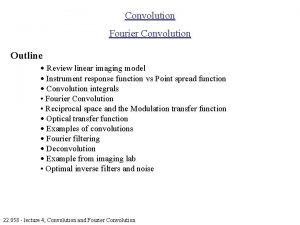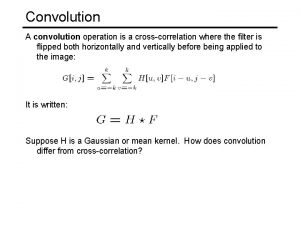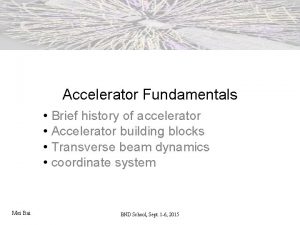LOGO A Convolution Accelerator for OR 1200 Dawei









![RTL Design and Optimization input a[8] b[8] invert padding zeroes a_new[15] b_new[15] result[15] output RTL Design and Optimization input a[8] b[8] invert padding zeroes a_new[15] b_new[15] result[15] output](https://slidetodoc.com/presentation_image_h2/a98439eb95445eb27880a970f20dcb2c/image-10.jpg)













- Slides: 23

LOGO A Convolution Accelerator for OR 1200 Dawei Fan

Contents 1 Introduction 2 Methodology 3 RTL Design and Optimization 4 Physical Layout Design 5 Conclusion

Introduction v What is convolution? § Convolution is defined as the integral of the product of the two functions after one is reversed and shifted. The convolution operation of f and g is denoted as f∗g.

Introduction v Discrete Convolution § Defined on set Z or Z+ , rather than R § Convolution is the array of the sum of the product of two arrays after one is reversed and shifted.

Introduction v What is convolution used for? § It shows the information of relevance, which is similar to cross-correlation § Applications in probability, statistics, signal processing § Computer vision, image processing § Convolution Code • Error-correcting code

Introduction v Motivation § Convolution could be completed in software program, DSP § A dedicated convolution accelerator could improve performance.

Methodology v 1. Read OR 1200 specifications and related RTL code. Study convolution algorithm further. v 2. RTL source code. v 3. Function verification in DVE. v 4. Repeat step 2 -3 to optimize RTL source code. v 5. Physical design with ICC and post layout verification.

RTL Design and Optimization 1. 0 2. 0 Convolution. v 3. 0 3. 1

RTL Design and Optimization v A basic implementation (1. 0) § Input: two arrays of 8 elements, 8 -bit § Output: an array of 15 elements, 16 -bit
![RTL Design and Optimization input a8 b8 invert padding zeroes anew15 bnew15 result15 output RTL Design and Optimization input a[8] b[8] invert padding zeroes a_new[15] b_new[15] result[15] output](https://slidetodoc.com/presentation_image_h2/a98439eb95445eb27880a970f20dcb2c/image-10.jpg)
RTL Design and Optimization input a[8] b[8] invert padding zeroes a_new[15] b_new[15] result[15] output

RTL Design and Optimization v Defects in 1. 0 § When using arrays as input, there will be errors unless adding “-sverilog” option § Too many ports § Not scalable

RTL Design and Optimization v Adding read and write (2. 0)

RTL Design and Optimization v Adding read and write (2. 0) § Sample input: • a[] = {1, 4, 5, 8, 6, 9, 11, 2} • b[] = {31, 25, 9, 7, 16, 19, 3, 2} § Sample output: • result[] = {3 e, 187, 23 c, 20 c, 24 c, 2 ae, 2 d 2, 218, 183, 131, ca, 7 b, 29, b, 2}16

RTL Design and Optimization v Combine calculation and write (3. 0)

RTL Design and Optimization v Combine calculation and write (3. 0) Write after calculation (2. 0) Write during calculation (3. 0)

RTL Design and Optimization v Final RTL code (3. 1) § Minor changes: change “integer” type to a 4 -bit register. § Input: din, 16 -bit § Output: dout, 32 -bit § Control signals: • • • Clk: clock Rst: reset data Rd: read input data Ena: begin calculation and write Busy: indicating calculation and write is in process

RTL Design and Optimization v Final RTL code (3. 1)

RTL Design and Optimization v Final RTL code (3. 1)

Physical Layout Design v IC Compiler Design Flow § Generate convolution_dc. v from DC § Modify scripts: • Change libraries path • Change routing parameters § Generate gds, FRAM, CEL

Physical Layout Design

Physical Layout Design v Area and Power report

Conclusion v Design a convolution accelerator for OR 1200 CPU v Verify basic functions in DVE waveform v Make optimizations in RTL to reduce area v Implement physical layout according to ICC design flow

LOGO
 Integral convolution
Integral convolution Offshore wind accelerator
Offshore wind accelerator Stanford
Stanford Asean graduate program
Asean graduate program Transformational leadership questionnaire tlq
Transformational leadership questionnaire tlq Ccat azure accelerator
Ccat azure accelerator Atlas accelerator module
Atlas accelerator module Coherent accelerator processor interface
Coherent accelerator processor interface Particle accelerator
Particle accelerator Medical particle accelerator
Medical particle accelerator Fiscal policy ib
Fiscal policy ib Accelerator
Accelerator Sap citizen engagement accelerator
Sap citizen engagement accelerator Stanford linear accelerator tours
Stanford linear accelerator tours Erik adli
Erik adli Compost accelerator homebase
Compost accelerator homebase Cern accelerator complex
Cern accelerator complex Accelerator theory of investment
Accelerator theory of investment Intelligent platform management interface market demand
Intelligent platform management interface market demand Cern accelerator school 2021
Cern accelerator school 2021 Dielectric wall accelerator
Dielectric wall accelerator Extensor: an accelerator for sparse tensor algebra
Extensor: an accelerator for sparse tensor algebra Salesforce cpq accelerator
Salesforce cpq accelerator Accelerator coherency port
Accelerator coherency port
